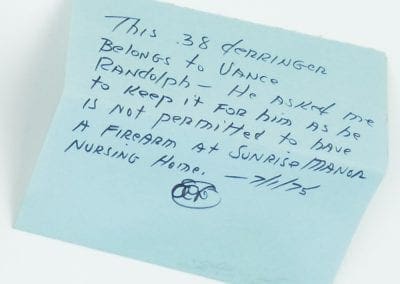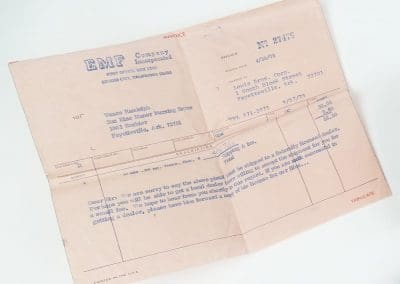by Sandra Cox Birchfield | Blog, Holidays, Sports and Recreation
Football Is a Thanksgiving Tradition
When the Arkansas Industrial University Cardinals ran on the football field for the first time in 1894, it did so only 24 years after Congress declared Thanksgiving a national holiday. As new autumn traditions, it was almost inevitable that football and Thanksgiving would be celebrated together. Indeed, football is a Thanksgiving tradition even here in the Ozarks.
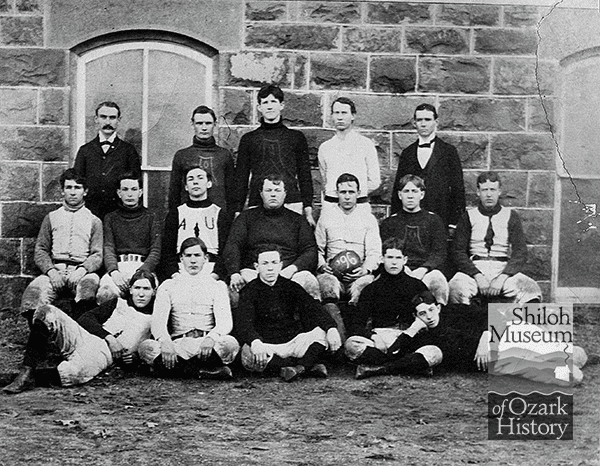
This photo of the Arkansas Industrial University football team was taken in 1896, two years after its formation and Thanksgiving Day trouncing by the University of Texas. Latin Professor John Futrall, who coached the team in its early years, is on the third row, far right, wearing a dark suit. He would later become president of the institution after it was renamed the University of Arkansas. Photo is from the Shiloh Museum of Ozark History’s Washington County Historical Society Collection (P-793).
The new Cardinals football team had an unlikely coach in John C. Futrall, a young Latin professor who later became president of the institution after it was renamed the University of Arkansas. Futrall was tasked with leading the very green Cardinals in an 1894 Thanksgiving Day match in Austin with the more experienced University of Texas team. The outcome was nothing short of humiliating. Texas soundly handed the Cardinals their birdseed by scoring 54 points. Arkansas couldn’t even get on the scoreboard. An intense Arkansas-Texas rivalry had begun.
Razorback Football Is a Thanksgiving Tradition
As years passed, the Cardinals became stronger and more threatening. When Arkansas defeated LSU in 1909, then-coach Hugo Bezdek declared his team had played “like a bunch of Razorback hogs.” A few weeks later, the team lived up to Bezdek’s assessment in a Thanksgiving game in Little Rock against Washington University, who lost with a score of 34 to 0. Arkansas celebrated its first-ever undefeated season, and The Arkansas Gazette proclaimed a “new era” for the “cardinal-clad gladiators.” A year later, this new powerhouse became the Razorbacks.
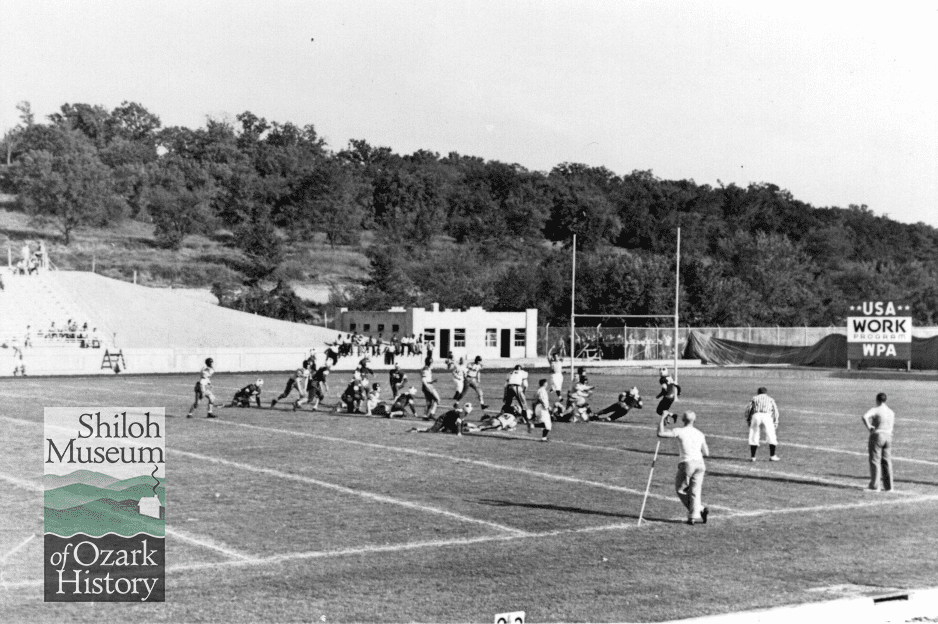
The Arkansas Razorbacks appear to have made a touchdown in this photo taken on the University of Arkansas campus in 1938, a year before President Franklin Roosevelt shook up Thanksgiving Day football plans by moving the holiday up a week. Note the WPA sign in the photo. The Works Progress Administration was an infrastructure program created by Roosevelt as a way to pull the nation out of the Great Depression. Photo, taken by William Carl Smith, is from the Shiloh Museum of Ozark History’s Ada Lee Smith Shook Collection (S-2009-79-10).
A Challenge To Coaches
A challenge to Thanksgiving Day football came in August 1939 when President Franklin Roosevelt moved the holiday from the last Thursday of November to the fourth (November had five Thursdays that year) to help boost the Depression-era economy with a few extra shopping days before Christmas. It also boosted outrage by football coaches who now faced a dilemma: how to reschedule their Thanksgiving Day football game on short notice, including the Razorbacks’ game against Tulsa. (So upset, Ouachita Baptist College’s coach in Arkadelphia threatened to vote Republican!) Many governors heard these outcries, including Arkansas’ and Oklahoma’s, and ignored Roosevelt’s declaration. The Razorbacks played Tulsa as originally planned and won.
Now, all states observe Thanksgiving on November’s fourth Thursday with millions spending the day watching their favorite professional football teams compete on television. Without a doubt, football is a Thanksgiving tradition. Thanksgiving Day Razorback football, however, didn’t survive. Yet a newer tradition takes place: Razorback football on Black Friday.
Originally published in the November/December 2022 issue of Butterfield LIFE magazine for Butterfield Trail Village, Inc.
Footnotes
Henry, O., & Bailey, J. (1996). “Instantly in the Red”. In The Razorbacks: A Story of Arkansas Football (pp.6–7, 23-25). essay, University of Arkansas Press.
The Thanksgiving holiday. US House of Representatives: History, Art & Archives. (n.d.). Retrieved September 29, 2022, from History.House.gov.
Serving Arkansas and Beyond. University of Arkansas. (n.d.). Retrieved October 3, 2022, from Uark.edu/athletics.
Arkansas is at Last Triumphant. (1909, November 26). The Arkansas Gazette, p. 1.
Odom, J. (2022, September 30). Razorbacks football team. Encyclopedia of Arkansas. Retrieved October 3, 2022, from Encyclopedia of Arkansas.
Infoplease. (n.d.). Perpetual calendar. Infoplease. Retrieved October 3, 2022, from https://www.infoplease.com/calendar/193911
Arkansas Football Coaches Bemoan Changing of Thanksgiving Holiday. (1939, August 15). Hope Star, p. 4.
Associated Press. (1939, November 23). Half of States Are Thankful Today, Rest Will Wait a Week. The Daily Oklahoman, p. 20.
Associated Press. (1939, December 1). Porkers Win Easily Over Tulsa, 23-0. Northwest Arkansas Times, p. 9.
by Susan Young | Artifact of the Month, Miscellaneous
 Donated by Frances Deane Alexander
Donated by Frances Deane Alexander
Ozark folklorist Vance Randolph purchased this Derringer handgun in 1975. At that time, he and his wife, folklorist Mary Celestia Parler, lived at Sunrise Manor Nursing Home in Fayetteville. Randolph’s good friend, journalist and historian Ernie Deane, helped Randolph acquire the gun. According to a note written by Deane on July 1, 1975: “This .38 Derringer belongs to Vance Randolph. He asked me to keep it for him has he is not permitted to have a firearm at Sunrise Manor Nursing Home.” (Ernie Deane had a delightful habit of writing brief notes of explanation about items of historical importance that he owned, storing his note with the item for posterity.)
Ernie Deane’s daughter, Fran Alexander, recounts the story of Ernie, Vance, and the Derringer:
“Ernie and Vance had a special relationship. They understood each other.
“Understanding another person, however, does not always put you in a comfortable position. When Vance requested that Ernie be on the receiving end of a pistol mail-order that Vance wanted to place, Ernie began to imagine the problems that might arise when he brought the Derringer into the Sunrise Manor Nursing Home, where Vance and his wife, Mary Parler, lived.
“Vance had assured Ernie that he had no delusions about harboring a pistol in a nursing home, but since he’d always wanted one, he figured it was now or never and asked Ernie, as a friend, to just bring it to him for a visit occasionally. He just wanted to look at it and hold it in his hands.
“This seemed a harmless enough request from an old and very helpless friend, but Ernie was constantly looking over his shoulder for nurses when the Derringer was visiting at Sunrise. He imagined the consequences would be dire, the worst probably being forbidden from ever visiting Vance again.
“Whatever memories, imagined exploits, or real adventures, or why Vance felt admiration for this brand of pistol, will probably never be known, since neither Ernie nor Vance wrote down his feelings on the subject.
“Another of Vance’s requests that Ernie also delivered on was an occasional pint of whiskey, which was not just a visitor, but kept hidden and used “for medicinal purposes.” A bit anxious that his bootlegging activities would also be discovered by the staff always put a sense of suspense and naughtiness into Ernie’s Sunrise visits, probably making the time spent with Vance and Mary even more fun for all concerned.
“When Vance died in 1980, he was buried in one of Ernie’s suits.”
Derringer for website 1
From left: Derringer invoice dated April 30, 1975; Derringer box with handgun and holster; note by Ernie Deane.
derringer-ernie-note
Note written by Ernie Deane, explaining backstory of the Derringer.
derringer-invoice
Derringer invoice, showing it sold to Vance Randolph for $52.50 and shipped to Lewis Bros. on the Fayetteville square (present-day Bank of Fayetteville location).

Donated by Frances Deane Alexander
Ozark folklorist Vance Randolph purchased this Derringer handgun in 1975. At that time he and his wife, folklorist Mary Celestia Parler, lived at Sunrise Manor Nursing Home in Fayetteville. Randolph’s good friend, journalist and historian Ernie Deane, helped Randolph acquire the gun. According to a note written by Deane on July 1, 1975: “This .38 Derringer belongs to Vance Randolph. He asked me to keep it for him has he is not permitted to have a firearm at Sunrise Manor Nursing Home.” (Ernie Deane had a delightful habit of writing brief notes of explanation about items of historical importance that he owned, storing his note with the item for posterity.)
Ernie Deane’s daughter, Fran Alexander, recounts the story of Ernie, Vance, and the Derringer:
“Ernie and Vance had a special relationship. They understood each other.
“Understanding another person, however, does not always put you in a comfortable position. When Vance requested that Ernie be on the receiving end of a pistol mail-order that Vance wanted to place, Ernie began to imagine the problems that might arise when he brought the Derringer into the Sunrise Manor Nursing Home, where Vance and his wife, Mary Parler, lived.
“Vance had assured Ernie that he had no delusions about harboring a pistol in a nursing home, but since he’d always wanted one, he figured it was now or never and asked Ernie, as a friend, to just bring it to him for a visit occasionally. He just wanted to look at it and hold it in his hands.
“This seemed a harmless enough request from an old and very helpless friend, but Ernie was constantly looking over his shoulder for nurses when the Derringer was visiting at Sunrise. He imagined the consequences would be dire, the worst probably being forbidden from ever visiting Vance again.
“Whatever memories, imagined exploits, or real adventures, or why Vance felt admiration for this brand of pistol, will probably never be known, since neither Ernie nor Vance wrote down his feelings on the subject.
“Another of Vance’s requests that Ernie also delivered on was an occasional pint of whiskey, which was not just a visitor, but kept hidden and used “for medicinal purposes.” A bit anxious that his bootlegging activities would also be discovered by the staff always put a sense of suspense and naughtiness into Ernie’s Sunrise visits, probably making the time spent with Vance and Mary even more fun for all concerned.
“When Vance died in 1980, he was buried in one of Ernie’s suits.”
Derringer for website 1
From left: Derringer invoice dated April 30, 1975; Derringer box with handgun and holster; note by Ernie Deane.
derringer-ernie-note
Note written by Ernie Deane, explaining backstory of the Derringer.
derringer-invoice
Derringer invoice, showing it sold to Vance Randolph for $52.50 and shipped to Lewis Bros. on the Fayetteville square (present-day Bank of Fayetteville location).
by Susan Young | Artifact of the Month, Business and Occupations, Crafts
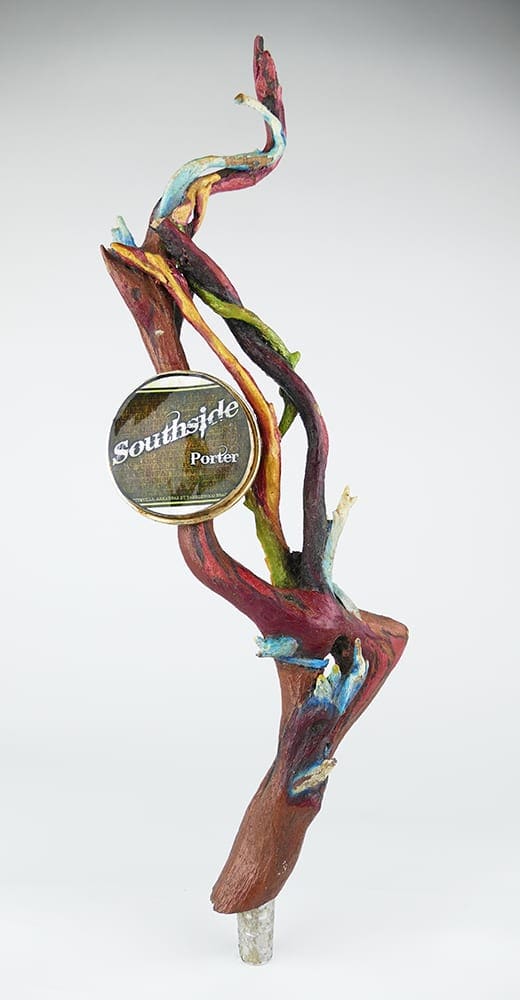 Donated by J. T. Wampler
Donated by J. T. Wampler
J. T. Wampler has been a photographer for Northwest Arkansas Newspapers for almost two decades. Taking a name from a local creek, he opened Tanglewood Branch Brewing Company located at the intersection of South School Avenue and Fifteenth Street in Fayetteville in September 2011. Initially he sold food made from local ingredients along with local and regional beers. In March 2012 Wampler obtained brewing permits and by the end of May, he was serving in-house brewed beer. However, by the end of 2013, the business was in jeopardy. A fundraising campaign raised over $21,000, allowing Tanglewood to remain open until September 2014..
This tap handle was made for Southside Porter, one of Tanglewood’s most popular brewed beers. Wampler commissioned artist Rae Russell to create original tap handles for all of Tanglewood’s in-house beers. Russell also painted “Bountiful Fayetteville,” the PIGshibition sculpture in front of Fayetteville’s Clinton House Museum.

Donated by J. T. Wampler
J. T. Wampler has been a photographer for Northwest Arkansas Newspapers for almost two decades. Taking a name from a local creek, he opened Tanglewood Branch Brewing Company located at the intersection of South School Avenue and Fifteenth Street in Fayetteville in September 2011. Initially he sold food made from local ingredients along with local and regional beers. In March 2012 Wampler obtained brewing permits and by the end of May, he was serving in-house brewed beer. However, by the end of 2013, the business was in jeopardy. A fundraising campaign raised over $21,000, allowing Tanglewood to remain open until September 2014..
This tap handle was made for Southside Porter, one of Tanglewood’s most popular brewed beers. Wampler commissioned artist Rae Russell to create original tap handles for all of Tanglewood’s in-house beers. Russell also painted “Bountiful Fayetteville,” the PIGshibition sculpture in front of Fayetteville’s Clinton House Museum.
by Susan Young | Artifact of the Month, Holidays
 Donated by Virginia Hicks
Donated by Virginia Hicks
This papier maché egg probably belonged to twins Mary and Ellen Russell of Harrison (Boone County) in the early 1920s. Mary and Ellen were born to Jesse and Rose Grever Russell in 1917. According to the 1920 census, the Russells lived at 614 West Central Avenue in Harrison. Jesse Russell was an editor of the Boone County Headlight newspaper. In 1947 he authored Behind These Ozark Hills, a collection of personal reminiscences about life in Carroll and Boone counties.
Germany has a long history of using papier maché eggs to celebrate Easter. From the late 1800s until the early 1930s, Germany exported empty papier maché eggs to the United States and throughout Europe. The word “GERMANY” stamped inside the egg helps narrow down when it was made. Up until about 1920, papier maché eggs manufactured in Germany were stamped “German” or “Germany.” From 1921 until 1933 they were stamped “German Republic. Following World War II, several stamps were used, including “East Germany,” “German Democratic Republic,” “West Germany,” and “Federal Republic of Germany.”

Donated by Virginia Hicks
This papier maché egg probably belonged to twins Mary and Ellen Russell of Harrison (Boone County) in the early 1920s. Mary and Ellen were born to Jesse and Rose Grever Russell in 1917. According to the 1920 census, the Russells lived at 614 West Central Avenue in Harrison. Jesse Russell was an editor of the Boone County Headlight newspaper. In 1947 he authored Behind These Ozark Hills, a collection of personal reminiscences about life in Carroll and Boone counties.
Germany has a long history of using papier maché eggs to celebrate Easter. From the late 1800s until the early 1930s, Germany exported empty papier maché eggs to the United States and throughout Europe. The word “GERMANY” stamped inside the egg helps narrow down when it was made. Up until about 1920, papier maché eggs manufactured in Germany were stamped “German” or “Germany.” From 1921 until 1933 they were stamped “German Republic. Following World War II, several stamps were used, including “East Germany,” “German Democratic Republic,” “West Germany,” and “Federal Republic of Germany.”
by Susan Young | Artifact of the Month, Household Goods, Tools

Donated by Mary Kwas
Gaines Tucker and his wife, Estelle “Essie” Dill West Tucker, used this handmade fireplace poker at their home in the Dean community near Metalton (Carroll County). After Gaines Tucker lost his job during the Great Depression, the Tuckers moved to the Ozarks from North Carolina in the early 1930s. They bought an old cabin on ten acres in Carroll County, where Gaines farmed and Essie ran a second-hand clothing shop out of their home to help make ends meet. Gaines died in 1940 and Essie stayed on in the cabin until her death in 1951.
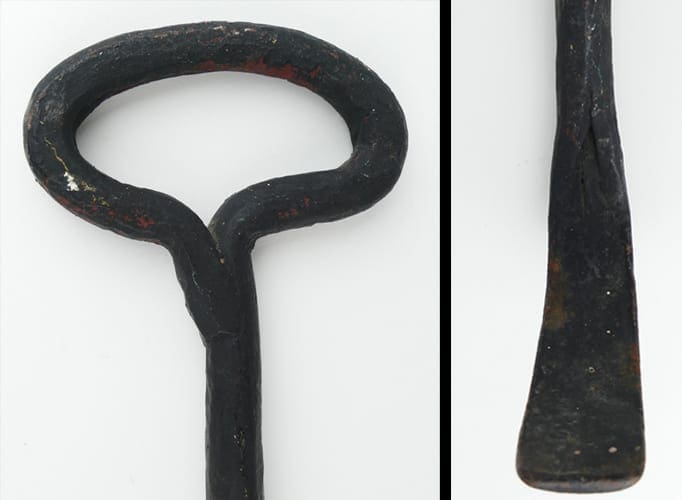
Closeup of handle and poker end.
by Susan Young | Artifact of the Month, Business and Occupations
Donated by the Ball Corporation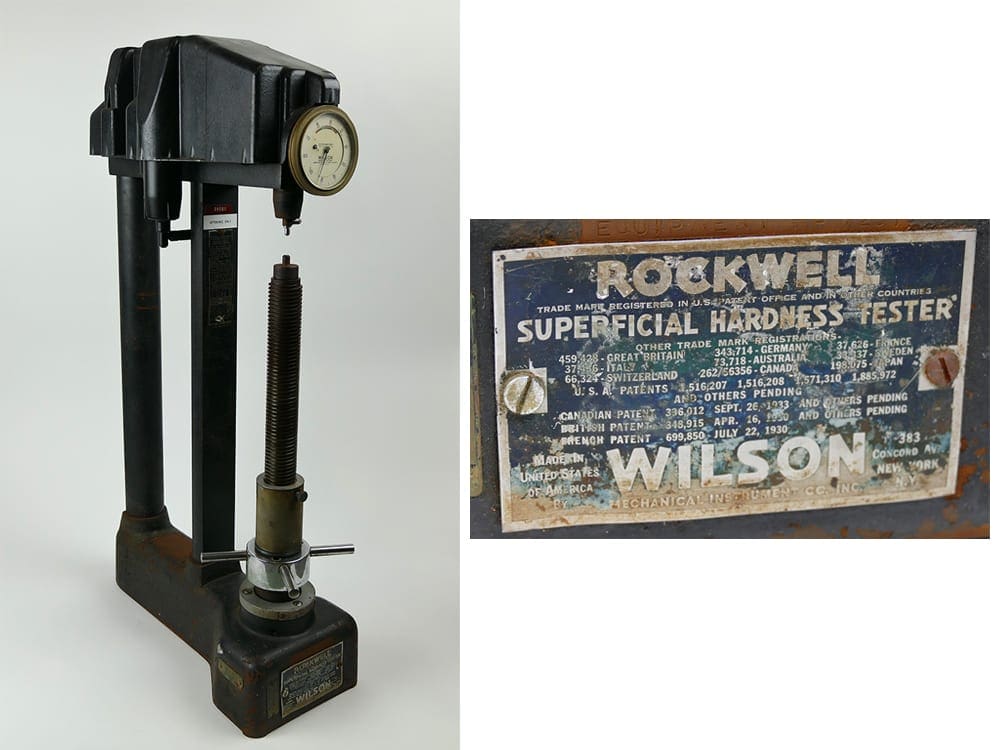
The Rockwell hardness tester was used to determine the strength, or “hardness,” of metal. Hardness was measured by attempting to put a dent into metal with increasing pressure, with the corresponding hardness number indicated on a gauge. The hardness tester seen here used a conical diamond to make the dent.
The history behind this particular tester is not completely known. Most recently it served at Heekin Can Company in Springdale. However, the tester has a metal tag identifying it as property of the “Defense Plant Corporation” or DPC. The DPC was created in 1940 to help with the war effort during World War II. Various wartime federal agencies would make a request for manufactured goods and the DPC would make sure that factories were able to deliver. Over six years the DPC distributed over nine billion dollars on 2,300 projects across forty-six states and overseas. Most of that money was spent building and equipping new factories and mills, which were primarily leased to private companies.
The metal tag also has “Frigidaire” engraved on it. Frigidaire Appliance Company made many components during World War II, including propellers, fuel tanks, and machine guns.
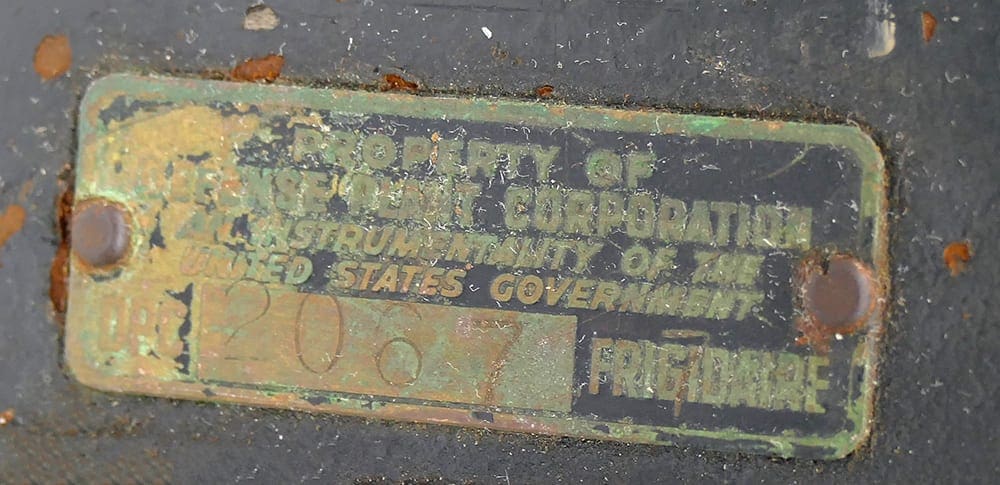
Metal tag on hardness tester.
Heekin Can Company was founded in Cincinnati, Ohio, by James Heekin in 1901. Son James J. Heekin took over the business in 1904 following his father’s passing. A second plant was added in 1915, and Heekin went on to become the largest regional manufacturer of metal food containers in the U.S., with factories in Arkansas, Illinois, Indiana, Ohio, Pennsylvania, Tennessee, West Virginia, and Wisconsin.
In the 1940s, Springdale was the center of Northwest Arkansas’s agricultural and canning industries. Heekin decided to locate a plant in Springdale to provide packing cans for locally processed fruits and vegetables. On June 4, 1949, the grand opening of Springdale’s Heekin Can Company was met with much fanfare, including speeches by Heekin president Daniel Heekin, Frisco Railroad vice president John Payne, and Arkansas highway commissioner Orval Faubus. The Springdale High School Band and Slim Picken’s Famous Western Band provided musical entertainment as some 4,000 visitors toured the new factory. Free soda pop and fried chicken box lunches were provided for all in attendance.
Heekin remained under family control until 1965 when it was sold to Diamond International to avoid a possible hostile takeover. In 1982 Heekin was sold as an independent company to Wesray Holding Corporation following a hostile takeover of Diamond. Three years later Heekin went public. Ball Corporation acquired Heekin in 1993. Phaseout of operations at the Springdale facility began in 2019, with the final plant closure expected sometime in 2021.
Learn more about Springdale’s Heekin Canning Company and the local canning industry in our Canned Gold online exhibit.

Donated by the Ball Corporation
The Rockwell hardness tester was used to determine the strength, or “hardness,” of metal. Hardness was measured by attempting to put a dent into metal with increasing pressure, with the corresponding hardness number indicated on a gauge. The hardness tester seen here used a conical diamond to make the dent.
The history behind this particular tester is not completely known. Most recently it served at Heekin Can Company in Springdale. However, the tester has a metal tag identifying it as property of the “Defense Plant Corporation” or DPC. The DPC was created in 1940 to help with the war effort during World War II. Various wartime federal agencies would make a request for manufactured goods and the DPC would make sure that factories were able to deliver. Over six years the DPC distributed over nine billion dollars on 2,300 projects across forty-six states and overseas. Most of that money was spent building and equipping new factories and mills, which were primarily leased to private companies.

Metal tag on hardness tester.
The metal tag also has “Frigidaire” engraved on it. Frigidaire Appliance Company made many components during World War II, including propellers, fuel tanks, and machine guns.
Heekin Can Company was founded in Cincinnati, Ohio, by James Heekin in 1901. Son James J. Heekin took over the business in 1904 following his father’s passing. A second plant was added in 1915, and Heekin went on to become the largest regional manufacturer of metal food containers in the U.S., with factories in Arkansas, Illinois, Indiana, Ohio, Pennsylvania, Tennessee, West Virginia, and Wisconsin.
In the 1940s, Springdale was the center of Northwest Arkansas’s agricultural and canning industries. Heekin decided to locate a plant in Springdale to provide packing cans for locally processed fruits and vegetables. On June 4, 1949, the grand opening of Springdale’s Heekin Can Company was met with much fanfare, including speeches by Heekin president Daniel Heekin, Frisco Railroad vice president John Payne, and Arkansas highway commissioner Orval Faubus. The Springdale High School Band and Slim Picken’s Famous Western Band provided musical entertainment as some 4,000 visitors toured the new factory. Free soda pop and fried chicken box lunches were provided for all in attendance.
Heekin remained under family control until 1965 when it was sold to Diamond International to avoid a possible hostile takeover. In 1982 Heekin was sold as an independent company to Wesray Holding Corporation following a hostile takeover of Diamond. Three years later Heekin went public. Ball Corporation acquired Heekin in 1993. Phaseout of operations at the Springdale facility began in 2019, with the final plant closure expected sometime in 2021.
Learn more about Springdale’s Heekin Canning Company and the local canning industry in our Canned Gold online exhibit.





